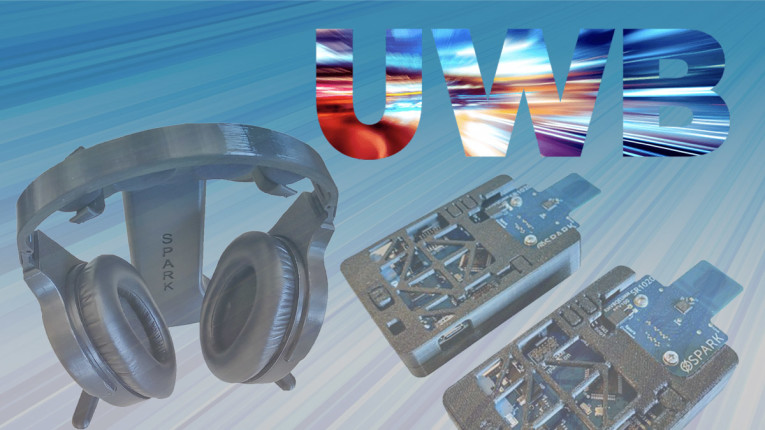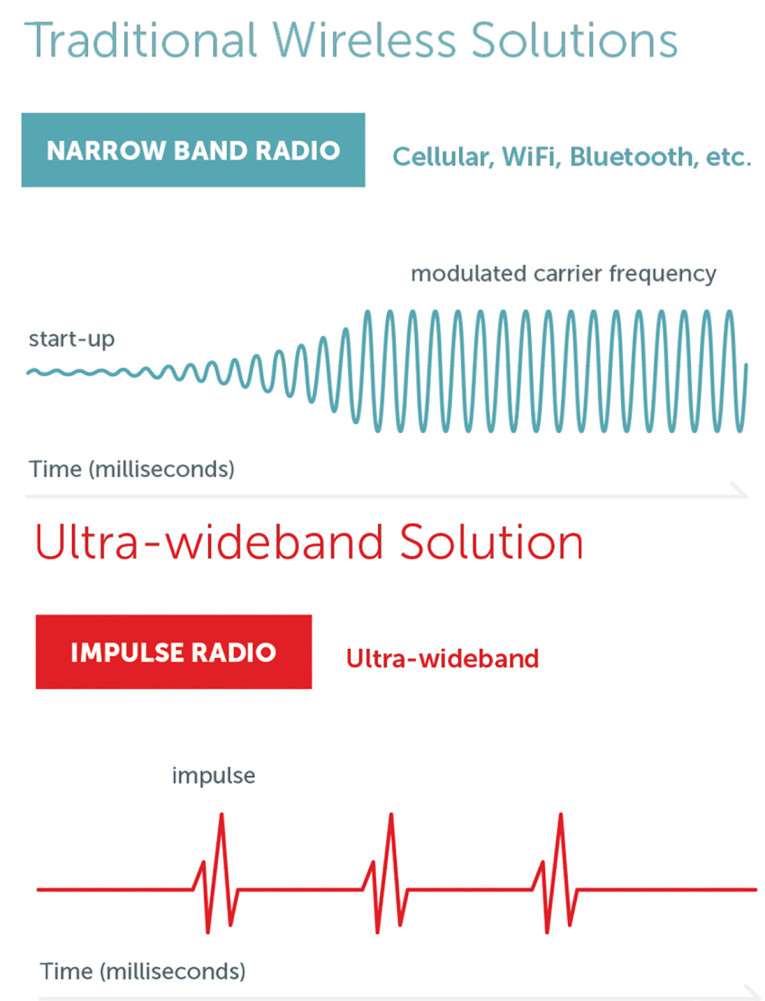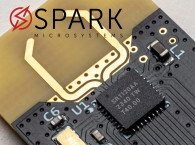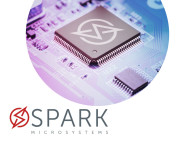
For the short-range wireless delivery of audio and multimedia, the performance capabilities of Bluetooth/Bluetooth Low Energy (BLE) and Wi-Fi are well understood to product designers and consumers alike. Bluetooth/BLE provides mobile-friendly power efficiency, but with extremely low data rates (typically < 1Mbit/sec) and high latency compared to Wi-Fi. Bluetooth’s low data rate forces compression to be used that increases audio latency and also reduces audio quality.
The Wi-Fi local area network communications standard, on the other hand, is well suited in many respects for high data throughput applications and supports a wider range/distance — but at a huge power penalty and long latency that makes Wi-Fi impractical for tomorrow’s mobile apps.
The advent of ultra-wideband (UWB) technology presents a new and compelling short-range wireless option that blends the best of both worlds of Bluetooth and Wi-Fi (Figure 1). UWB achieves ultra-low power and ultra-low latency, with up to 10× higher data throughput than BLE. It’s optimized for high-quality audio and emerging AR/VR applications serviced by smart glasses and other wireless peripheral devices requiring higher data rates and lower latency.

UWB technology can provide more immediate benefits in the traditional audio domain, where it’s applicable for the next generation of wireless headsets, speakers and more. UWB’s promise to deliver “wired like” audio quality without the wires — there’s no compression needed — is enormously enticing for anyone who laments the loss of audio quality we experienced decades ago when we largely jettisoned wired audio connectivity in favor of mobile-friendly wireless audio devices.
UWB’s value proposition extends beyond the audio domain, however, and acknowledges the coming convergence of traditional multimedia delivery with high-speed human interface device (HID) control and positioning capabilities. The augmentative audio and video overlays delivered wirelessly to tomorrow’s smart glasses and audio devices, for example, will change the way we engage/interact with our environments. These devices will depend on innovations such as UWB to harness and transmit data wirelessly among our personal, body-borne electronic devices.
All three technologies — Bluetooth/BLE, Wi-Fi and UWB — will play a valuable role for tomorrow’s short-range wireless device connectivity, and their interaction and interoperability must be made seamless going forward. This requires, among other things, minimal interference between them, and here again UWB shines in its ability to enhance wireless audio and mobile AR experiences in congested environments.
Body & Personal Area Networks
UWB-enhanced devices can deliver data throughput and low latency performance on par with wired links — without the wires — to enable a new class of body area network (BAN) and personal area network (PAN) applications. We can think of BANs/PANs as the personal zones that surround each individual in a connectivity mesh incorporating their wearable wireless devices, distributing data between them in ways that fully immerse the user’s sense of sound, sight and touch — this is the vision of fully-realized AR/VR.
Bluetooth-connected wireless earbuds, paired with our smartphones, are a simple example of a modern BAN/PAN application in action. For the AR/VR-optimized devices of tomorrow, RF signals transmitted within our BANs/PANs will carry audio data as well as video and positioning data between several devices at once, all of which must be precisely orchestrated at extremely high speed in dynamic user environments.
This requires extreme low latency to enable real-time comms and positioning synchronization between devices to ensure true AR/VR-caliber responsiveness. After all, the quality of the AR/VR experience hinges completely on the quality of the communications. Signal interruptions and desynchronization distract us from the experience and interfere with our immersion. This challenge is magnified considerably in congested user environments, where signal interference can become problematic.
UWB stands alone as the short-range wireless technology that can deliver the high data throughput and ultra-low latency required for the real-time immersive AR and metaverse experiences of tomorrow. And UWB achieves this without introducing additional interference for physically adjacent Bluetooth/BLE and/or Wi-Fi devices — and/or other UWB devices.
SPARK Microsystems takes the UWB value proposition another step further by ensuring that the power consumption profile for these wireless audio and AR/VR peripherals will allow for lengthy usage times between battery charges. Again, this means fewer interruptions for more seamless immersion in the AR and metaverse environment.
These PAN/BAN-connected devices will become as ubiquitous and essential to our daily lives as our smartphones and earbuds are today, going with us wherever we go…for as long as their battery charges will last them. AR and the metaverse will be fundamentally mobile experiences, and we will be reliant on BAN/PAN-connected devices being charged and ready for use as we go about our day. Indeed, many consider the “holy grail” of fully realized AR smart glasses, wireless audio, and hardware peripherals to be the ability to effectively address the lingering power consumption challenge.
UWB Excels in Environments Congested by Existing BT/BLE and Wi-Fi Radios
There are several qualities unique to UWB that make it an ideal fit when it comes to enhancing wireless audio and AR/VR application user experience in congested environments.
Low RF Power — UWB delivers low spectral output power by default, required per regulatory standards. Most countries have now agreed on the maximum output power for UWB, defined as -41.3dBm/MHz, to avoid disturbing adjacent wireless communications.
UWB can coexist with other transmission standards and not interfere with them. It complements Bluetooth/BLE and Wi-Fi but does not compete with them or cause additional congestion. In fact, other radio systems will see UWB as background noise.
Low RF power naturally limits the range of UWB target applications to several feet/meters, thereby creating “personal zones” and reducing interference with nearby devices in congested environments. UWB range is limited to “near me” distances, making it ideal for indoor audio and AR/VR applications. This also serves to enhance the privacy of communication, confining it to a small “bubble.” Bluetooth and Wi-Fi’s sphere of influence on adjacent systems stretches far beyond the personal bubble required by most applications and therefore creates congestion with other users’ personal bubbles.
Low Power Consumption — The biggest difference between traditional narrowband RF systems and UWB is the underlying transmission method. UWB uses an impulse-style radio whereas the majority of narrowband radio systems use a modulated carrier frequency. Sending pulses rather than modulated sinewaves, SPARK’s implementation of UWB is considered a non-coherent impulse technology. With UWB, the underlying impulse radio technology means transmission is done power-efficiently in short bursts. Narrowband systems using a modulated carrier have to continually transmit the carrier signal during data transfer, requiring higher transmit power (Figure 2).

SPARK UWB uses proprietary technology to further lower the power consumption of the impulse radio. Combined with the low spectral output power benefit, UWB significantly reduces power consumption. By way of comparison, SPARK’s implementation of UWB consumes up to 40× less power than BLE.
This ultra-low power operation makes UWB extremely advantageous for small battery-powered applications, regardless of the data rate. Current consumption can be further optimized for battery operated devices including earbuds, headsets, microphones, portable speakers and more.
The combination of UWB’s wide frequency range, allowing for multiple channels, and the underlying impulse radio technology means that UWB is also less impacted by multipath phase distortion issues and can filter out unwanted interferers, making it more robust.
Co-Existence — UWB, Bluetooth/BLE, and Wi-Fi can readily coexist. Bluetooth occupies a different frequency band than UWB, so interference between them isn’t a pressing concern. But Bluetooth/BLE radio signals have a larger sphere of influence than required for BANs/PANs, and this can lead to congestion when many devices are in close proximity.
Wi-Fi connectivity is most beneficial for devices that are spaced apart (large homes, low density living areas, etc.). But the extended range becomes a disadvantage for live streaming applications for multiple users in high density areas where numerous Wi-Fi networks overlap (particularly in urban neighborhoods/cities). These represent potential sources of interference — and they’re all competing for the available bandwidth in the area of interest.
In some applications, it will likely make sense to use more than one radio type. A hybrid RF solution greatly improves the overall end user experience and offers system manufacturers considerably more flexibility. Co-existence between Bluetooth/BLE, Wi-Fi and UWB makes this easier.
Latency — UWB excels at enabling low latency wireless links. Link latency in a UWB system can be very low (less than 5ms for most audio applications), making it easy to keep audio signals in sync with each other and with other related sources such as video. Additionally, due to low latency control signals, audio/multimedia channels can be tightly synchronized (within 20µs) to deliver exceptional performance across a BAN/PAN or home sound system.
Distance Measurement — UWB can also measure distance between two radios using time-of-flight calculations: An impulse is sent from one device to another, and we measure the time it took from transmit to receive. The distance between objects can be determined accordingly, and this can be measured with picosecond accuracy with UWB chips.
We see this capability in action today via UWB-based positioning devices like Apple’s AirTags, designed to help identify the precise location of tagged objects with accuracy that’s within mere centimeters. This same UWB capability can be used to determine distance between audio components and devices, enabling the calibration of user-friendly spatial audio configurations for improved listening experiences.
SPARK Microsystems is the first mover in leveraging UWB for data delivery, enabling the ability for high-performance wireless audio/multimedia transport. Other UWB technology vendors, as well as the Institute of Electrical and Electronics Engineers (IEEE), are currently focusing their efforts on the positioning and distance measurement attributes of UWB.
Flexibility — UWB links can also contain piggyback data for configuration and diagnostic purposes, and bi-directional links are also possible. What’s more, UWB wireless audio links can dynamically scale up and down and adjust link rates to optimize audio quality for a given environment.
UWB’s support for multiple channels ensures that multiple audio and AR/VR devices can be used on the same BAN/PAN. UWB can also support broadcast and mesh modes, in addition to point-to-point (direct connection) schemes.
Unlicensed Spectrum — The UWB spectrum is unlicensed, so it’s free for everyone to enjoy! Each technology — Bluetooth/BLE, Wi-Fi and UWB — brings compelling attributes to the table that should be carefully weighed as we take a long view of our evolving short-range wireless needs into the future. UWB provides distinct advantages that blend the best attributes: ultra-low power and latency with high data throughput.
In Conclusion
These robust connectivity and communication properties make UWB ideally suited for the next generation of wireless audio devices. As wireless audio/multimedia delivery converges with HID and positioning data delivery for future AR/VR devices, UWB will ensure higher overall performance that’s optimized for mobile BANs/PANs.
Moreover, UWB provides significant benefits for high-quality, short-range wireless delivery in congested areas for smoother, seamless consumer audio and AR/VR experiences. For more information about UWB technology and SPARK Microsystems, please visit www.sparkmicro.com aX
About the Authors
 Dr. Frederic Nabki is a Co-Founder and the Chief Technology Officer of SPARK Microsystems where he directs the technological innovations that SPARK Microsystems is bringing to market. He has 17 years of experience in research and development of RFICs and MEMS. He obtained his Ph.D. in Electrical Engineering from McGill University in 2010. Dr. Nabki has contributed to setting the direction of the technological roadmap for start-up companies, coordinated the development of advanced technologies and participated in product development efforts. His technical expertise includes analog, RF, and mixed-signal integrated circuits and MEMS sensors and actuators. He has published several scientific publications, and he holds multiple patents on novel devices and technologies touching on microsystems and integrated circuits.
Dr. Frederic Nabki is a Co-Founder and the Chief Technology Officer of SPARK Microsystems where he directs the technological innovations that SPARK Microsystems is bringing to market. He has 17 years of experience in research and development of RFICs and MEMS. He obtained his Ph.D. in Electrical Engineering from McGill University in 2010. Dr. Nabki has contributed to setting the direction of the technological roadmap for start-up companies, coordinated the development of advanced technologies and participated in product development efforts. His technical expertise includes analog, RF, and mixed-signal integrated circuits and MEMS sensors and actuators. He has published several scientific publications, and he holds multiple patents on novel devices and technologies touching on microsystems and integrated circuits. Nicolas Paillusseau joined SPARK Microsystems as Applications Team lead in November 2021, with more than 15 years of professional semiconductor experience. Prior to joining SPARK Microsystems, Nicolas was a Senior Application Engineer at STMicroelectronics where he was involved in the development of various products, including mobile phones SoC with ST Ericsson, then TV set-top box SoC, and finally, the application development of STM32 32-bit Arm Cortex MCUs. Nicolas started his carrier as Hardware engineer at TCL & Alcatel Mobile phones.
Nicolas Paillusseau joined SPARK Microsystems as Applications Team lead in November 2021, with more than 15 years of professional semiconductor experience. Prior to joining SPARK Microsystems, Nicolas was a Senior Application Engineer at STMicroelectronics where he was involved in the development of various products, including mobile phones SoC with ST Ericsson, then TV set-top box SoC, and finally, the application development of STM32 32-bit Arm Cortex MCUs. Nicolas started his carrier as Hardware engineer at TCL & Alcatel Mobile phones. Ron Rinkenbach joined SPARK Microsystems as Senior Applications Specialist in April 2021. Ron is an engineering professional with background in electronic design and customer support roles working in industries such as Semiconductors, Avionics, Aerospace, and Communications. His previous roles include Field Sales Engineer at Axis Communications and Field Applications Engineer at Introspect Technology.
Ron Rinkenbach joined SPARK Microsystems as Senior Applications Specialist in April 2021. Ron is an engineering professional with background in electronic design and customer support roles working in industries such as Semiconductors, Avionics, Aerospace, and Communications. His previous roles include Field Sales Engineer at Axis Communications and Field Applications Engineer at Introspect Technology.This article was originally published in audioXpress, December 2022






